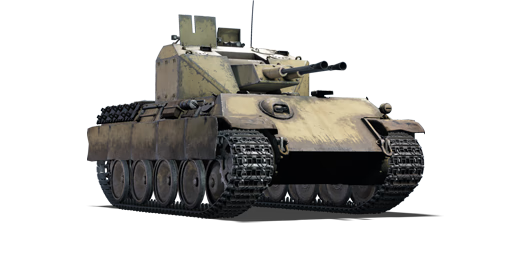Flakpanzer 341
Contents
Flakpanzer 341 (Coelian) was a self-propelled anti-aircraft gun design by Rheinmetall during World War II for the German armed forces. It was intended to be armed with two 3.7 cm FlaK 43 gun in a fully enclosed, rotating turret on the hull of a Panther medium tank but was not built before the end of the war in Europe.
In the first years of the war, the Wehrmacht had less interest in developing self-propelled anti-aircraft guns, but as the Allies developed air superiority, the need for more mobile and better-armed self-propelled anti-aircraft guns increased. The Wehrmacht had adapted a variety of wheeled and half-track vehicles to serve as mobile forward air defence positions to protect armour and infantry units in the field as well as for temporary forward area positions such as mobile headquarters and logistic points. As Allied fighter bombers and other ground attack aircraft moved from machine gun armament and bombing to air-to-ground rockets, the air defence positions were even more vulnerable. The answer was to adapt a tank chassis with a specialized turret that would protect the gun crews while they fired upon approaching Allied aircraft.
As a consequence, the German Army High Command issued a demand for an anti-aircraft tank based on the chassis of the Panther tank design. Rheinmetall developed "Coelian" in various versions, including one with four 20mm MG 151/20 guns, but kept having to revise designs based on changing government requirements (such as demands for more modern guns with longer barrels). Eventually, in May 1944 a turret with a single 5.5 cm gun was developed, together with another with twin 3.7 cm FlaK 43 guns.
However, it soon became clear that no chassis would be available for Flakpanzers for a variety of reasons, including the Allies' landing in Normandy, the increasing Allied strategic bombing offensive, and raw material shortages. By mid-February 1945, only a wooden prototype of the 3.7 cm turret model on a Panther D hull had been created.
General info
Survivability and armour
Describe armour protection. Note the most well protected and key weak areas. Appreciate the layout of modules as well as the number and location of crew members. Is the level of armour protection sufficient, is the placement of modules helpfull for survival in combat?
If necessary use a visual template to indicate the most secure and weak zones of the armour.
Mobility
Write about the mobility of the ground vehicle. Estimate the specific power and maneuverability as well as the maximum speed forward and backward.
Armaments
Main armament
Give the reader information about the characteristics of the main gun. Assess its effectiveness in a battle based on the reloading speed, ballistics and the power of shells. Do not forget about the flexibilty of the fire, that is how quickly the cannon can be aimed at the target, open fire on it and aim at another enemy. Add a link to the main article on the gun: {{main|Name of the weapon}}. Describe in general terms the ammunition available for the main gun. Give advice on how to use them and how to fill the ammunition storage.
Additional armament
Some tanks are armed with several guns in one or more turrets. Evaluate the additional weaponry and give advice on its use. Describe the ammunition available for additional weaponry. Give advice on how to use them and how to fill the ammunition storage. If there is no additional weaponry remove this subsection.
Machine guns
Offensive and anti-aircraft machine guns not only allow you to fight some aircraft, but also are effective against lightly armoured vehicles. Evaluate machine guns and give recommendations on its use.
Usage in the battles
Describe the tactics of playing in the vehicle, the features of using vehicles in the team and advice on tactics. Refrain from creating a "guide" - do not impose a single point of view but give the reader food for thought. Describe the most dangerous enemies and give recommendations on fighting them. If necessary, note the specifics of the game in different modes (AB, RB, SB).
Pros and cons
Summarize and briefly evaluate the vehicle in terms of its characteristics and combat effectiveness. Mark its pros and cons in a bulleted list. Do not use more than 6 points for each of the characteristics. Avoid using categorical definitions such as "bad", "good" and the like - they have a substitution in the form of softer "inadequate", "effective".
Pros:
Cons:
History
Describe the history of the creation and combat usage of the ground vehicle in more detail than in the introduction. If the historical reference turns out to be too big, take it to a separate article, taking a link to an article about the vehicle and adding a block "/historical reference" (example: https://wiki.warthunder.com/Name-vehicles/historical reference) and add a link to it here using the main template. Be sure to include links to sources at the end of the article.
Media
An excellent addition to the article will be video guides, as well as screenshots from the game and photos.
Read also
Links to the articles on the War Thunder Wiki that you think will be useful for the reader, for example,
- reference to the series of the vehicles;
- links to approximate analogues of other nations and research trees.
ETC.
Sources
Paste links to sources and external resources, such as:
- topic on the official game forum;
- other literature.




